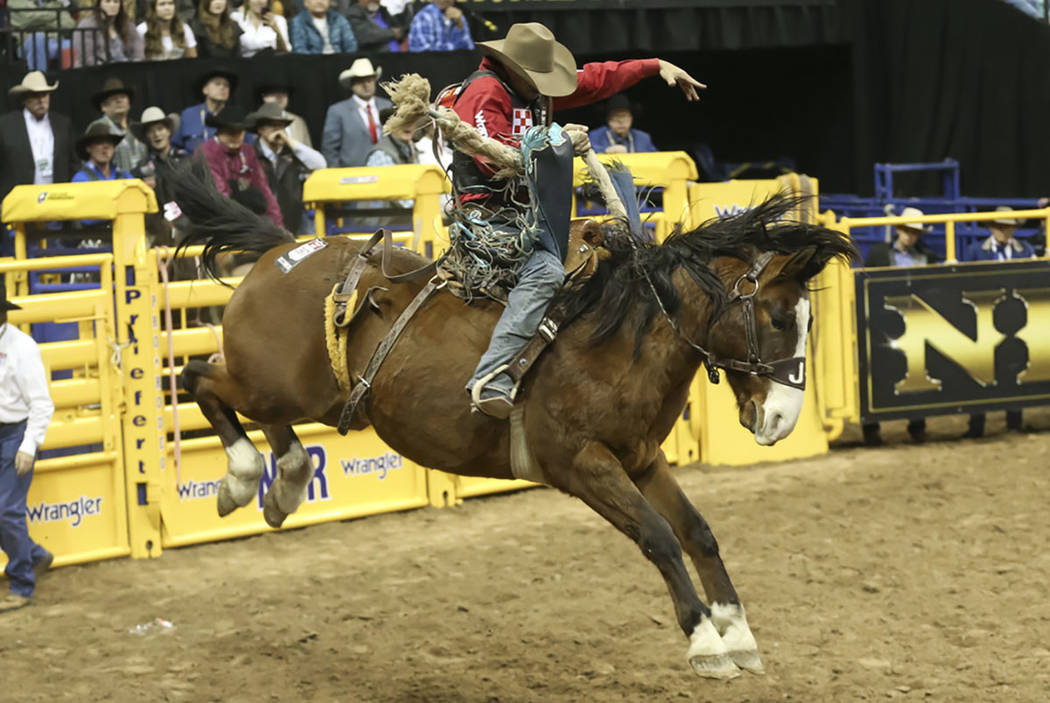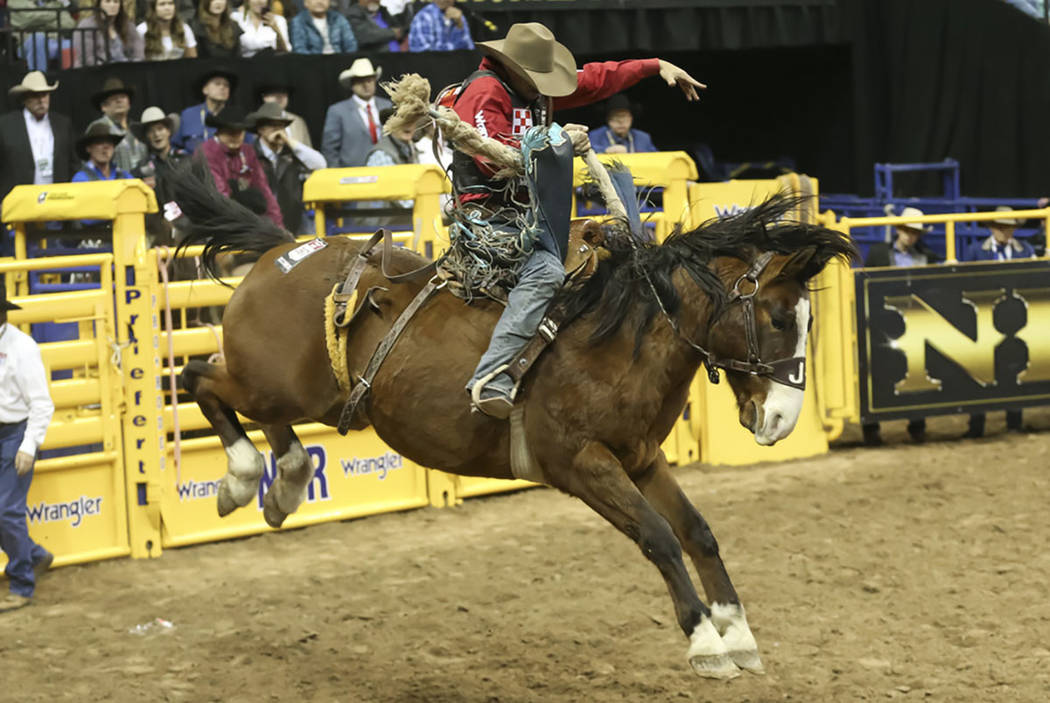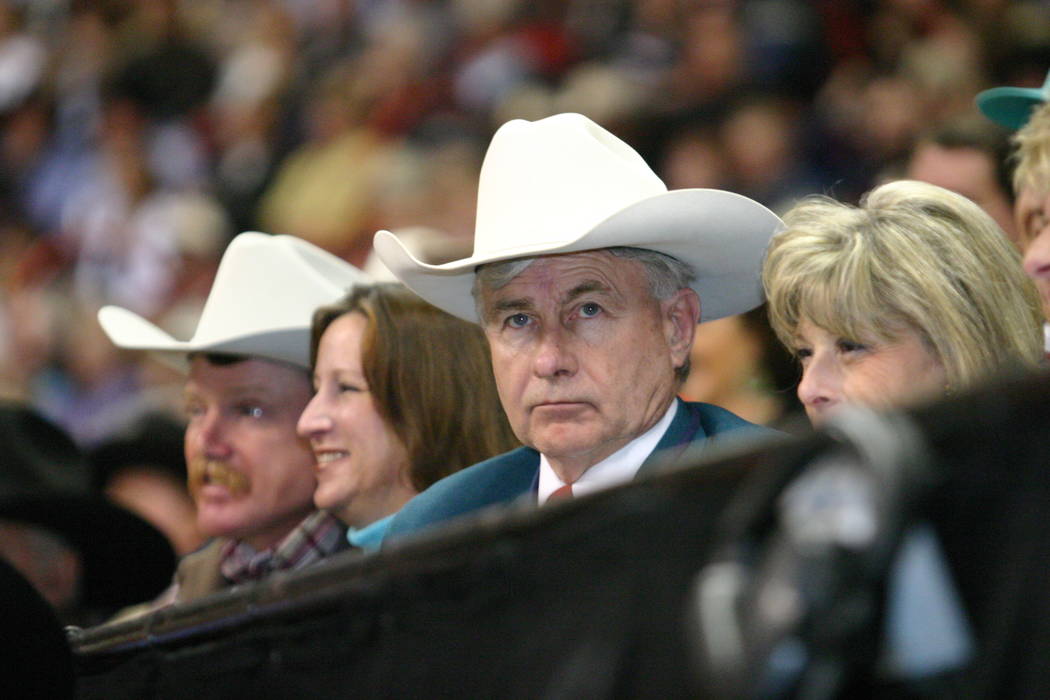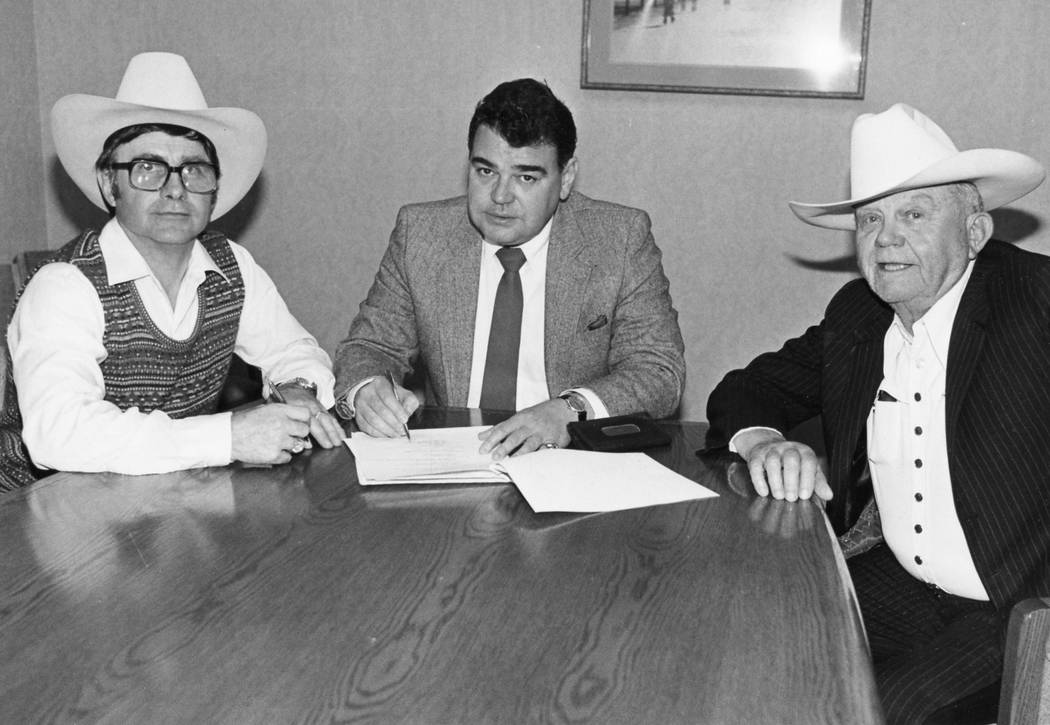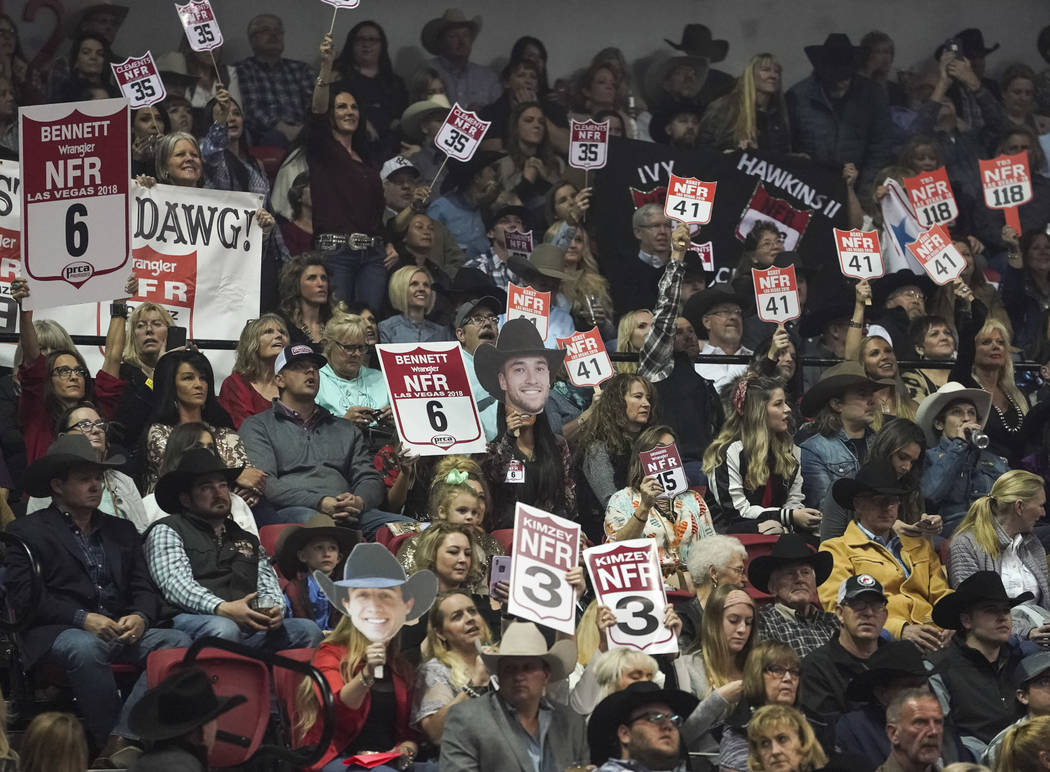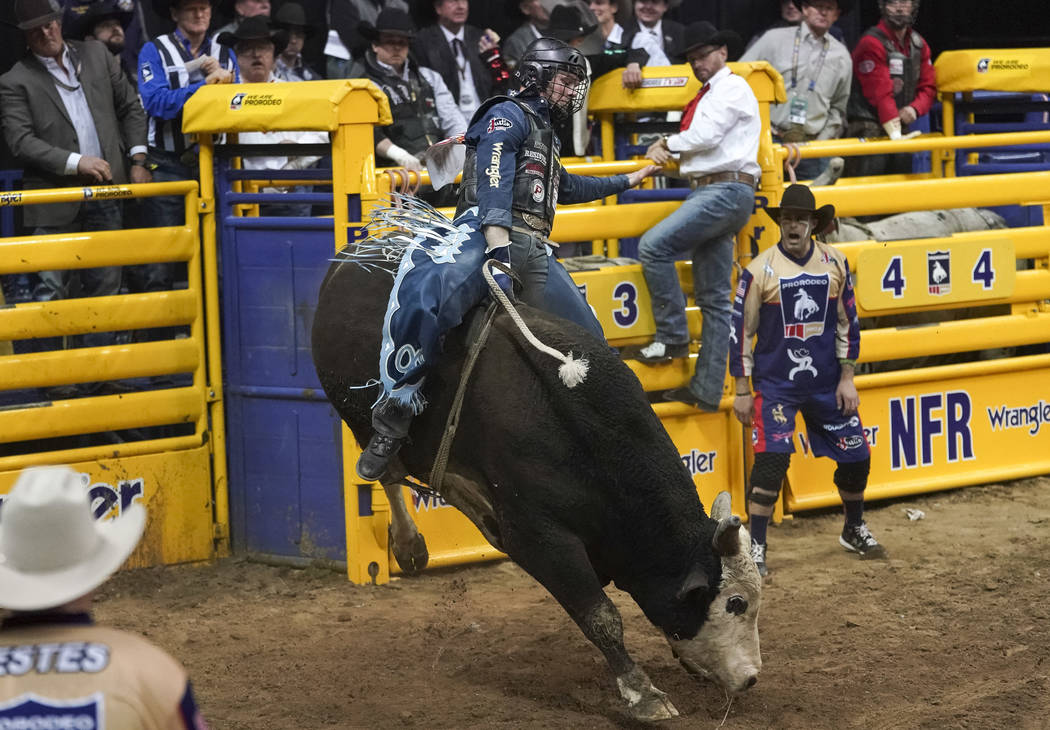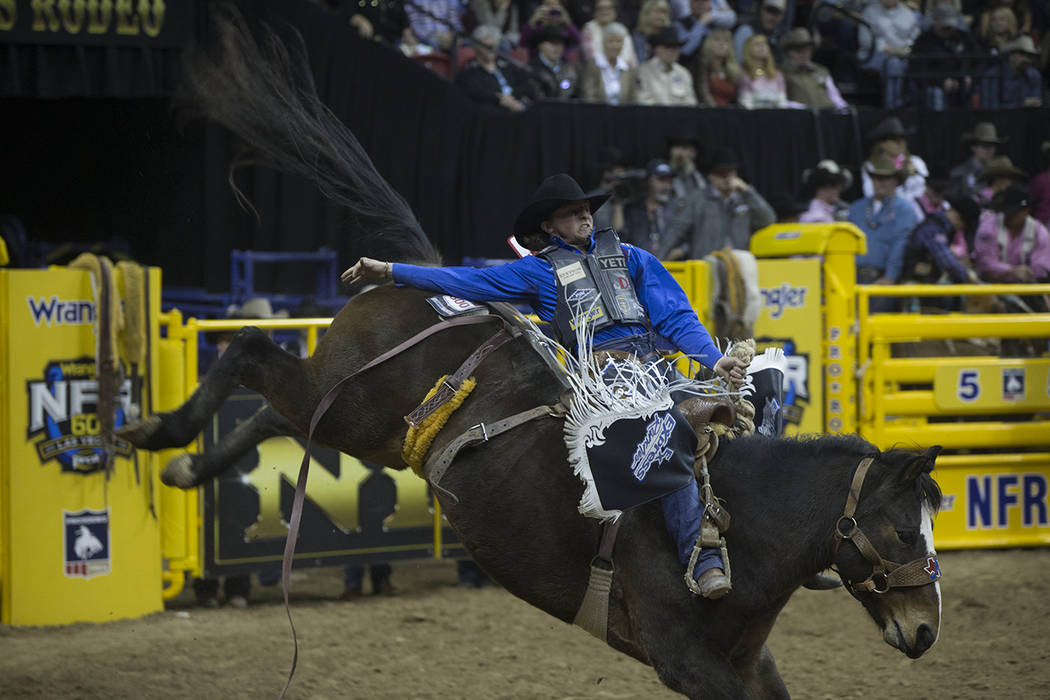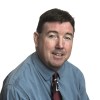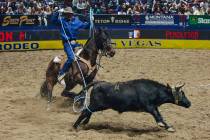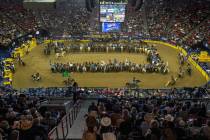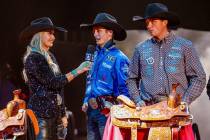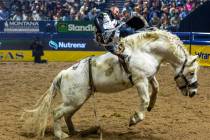NFR rides into Las Vegas for 35th year
As the Wrangler National Finals Rodeo rides into town for its 35th 10-day run at the Thomas &Mack Center, numerous individuals deserve credit for first bringing this event to Las Vegas in 1985, then turning it into the spectacle it has since become. Benny Binion is arguably at the top of that list, as he was influential in luring the Wrangler NFR from Oklahoma City to Vegas, then offered to put up his own money early on — if needed — to ensure its financial stability.
That proved unnecessary, since in 1987 — Year 3 in Las Vegas — the NFR began a run of sellout performances that continues to this day. Michael Gaughan, owner of the South Point Hotel &Casino, and Las Vegas Events president Pat Christenson were and remain key players in that success story.
But they both point to one person who really made this event a Las Vegas staple every December: Shawn Davis.
“Benny got it here, and Shawn changed the NFR’s format, tightened it to a two-hour rodeo,” Gaughan said, noting that prior to Davis taking over as the event’s general manager, NFR go-rounds could last 3½ hours or more. “Two hours is perfect for Las Vegas.”
Christenson put it in the context of stepping from one level to the next. The first level was bringing a much-needed event to the Thomas &Mack Center, which first opened in 1984 and was not financially solvent, even with UNLV men’s basketball in the midst of its heyday. At the time, Christenson was assistant director of the Thomas &Mack, and luring the Wrangler NFR helped ensure the arena’s long-term viability.
The second level, echoing Gaughan’s point, was fitting each go-round into a much more digestible time frame for the fans.
“That came from Shawn Davis. The philosophy of it being a 2-hour show instead of a 3- to 3.5-hour show, that was critical,” Christenson said. “When you look at the evolution of the NFR, the popularity became the pace of the show.”
Indeed, it’s a nonstop 120 minutes of action, becoming more so every year, which is all of Davis’ doing.
“The third level was Shawn adding the production part, sort of the rock ‘n’ roll part to create the tempo and the pace,” Christenson said. “He made it loud. We got four video boards, and as technology was expanding, he brought in four more video boards. That was another step in its evolution.
“In those first 10 years here, Shawn really rewrote the ground rules.”
Davis, who remained general manager through the 2018 NFR and is now in an advisory role, was quick to share credit for the rodeo’s success.
“I appreciate it,” he said. “That’s what we hoped to do. In all these things, it doesn’t just happen. You need a lot of good people to support you and make it happen. Some of my ideas were pretty different ideas at the time. Without progressive people behind me, we couldn’t have gotten it done.”
Davis agreed that the nightly run time was the fuel that powered every subsequent innovation.
“Two hours was kind of the magic number, and we had to put a lot of rodeo into two hours,” he said. “The NFR had become a 4-hour production. We wanted to match the best contestants with the best stock and focus the attention on the person watching it. That’s what I’ve always worked on to make the rodeo run like it does.”
With those efforts fully integrated and upgrades coming practically every year at the arena, the next phase of the NFR began taking shape in 2001, when Christenson joined Las Vegas Events.
“We had to better promote all that was going on around the rodeo,” Christenson said. “We saw more people coming to Las Vegas, regardless of whether they had tickets to the rodeo. We weren’t selling brand sponsorships. There was an opportunity for hotels to create something unique, and we provide the platform to promote it.”
So what began as the in-arena experience for the NFR, along with ancillary events such as the now-massive Cowboy Christmas at the Las Vegas Convention Center, evolved into an all-day, every-day experience. Across the city, there are now multiple events and cowboy/Western trade shows, nightly viewing parties at a plethora of hotels, lively after-parties running well into the night and a great concert scene, as well.
“Between 2001 and today, we created this template. In addition to this incredible event at the Thomas &Mack that we always had, you just add all of the improved experiences for fans,” Christenson said.
Allowing the rodeo to be broadcast live first at a few hotels, then extending that to dozens, with the actual in-arena feed of the rodeo announcers, was arguably the biggest stroke of genius. It created a nightly event around which many more events could be built: pre- and post-viewing parties, concerts, the nightly buckle presentations and more.
“When we finally got it on TV at the hotels, they thought it would hurt ticket sales. But it was the exact opposite. You still can’t get a ticket,” Gaughan said, while noting his showroom, lounges and convention halls overflow with rodeo watchers. “I pack over 5,000 people into the South Point every night just to watch the closed circuit. It’s amazing how many come and watch here and at other hotels. The live feed made the event bigger.”
Added Christenson: “The hotels create their own experiences. For the fans, it’s like they’re at the rodeo. I don’t think there’s any other example like it in sports, taking a 10-day, sold-out event, creating more content around it and promoting that content. You’ve created that 10-day Western lifestyle festival.”
In fact, Christenson compared the NFR with the massive Coachella music festival held each April in Indio, Calif., near Palm Springs.
“We have 200 different stages, and our footprint is the Strip and downtown,” he said. “It’s a very sophisticated festival in that you’ve created all this content. The whole city is using the NFR to create a 10-day lifestyle experience. And the best part is, I don’t think there’s any end to the growth.”
Technology is making sure of that. Davis and Christenson both noted that over the past few years, the Wrangler NFR has worked to integrate social media into the experience, be it at the arena or around town. And finding more ways for the rodeo to interact with fans in the stands — whether through the NFR mobile app or sing-alongs or dance-offs or the ever-popular kiss cam — is a foremost consideration with any new ideas.
“This is the beginning of that next step of getting those fans whatever they need to know,” Christenson said, while noting that Davis’ successor as GM, longtime NFR announcer Boyd Polhamus, will certainly carry the mantle well with the nightly in-arena experience. “I think you’ll see some really high-tech production from Boyd, and the other piece is the interactivity that we’re trying to create with the crowd. Just more of what we’ve had in the past. It gets a little better each year.”
That interactivity will go beyond the Thomas &Mack, as well, to include Cowboy Christmas, the viewing parties and many other tangents stemming from the NFR. In the end, though, it all comes back to the competition itself — those tightly produced nightly go-rounds, which have become the on-time machine of all on-time machines, while generating more excitement every year.
“You never know what you’re gonna see in competition, but we’ve now got an answer for every question that could come up,” Davis said. “We’ve rehearsed it and discussed it. That’s why we can keep everything on track. We average within 2 to 3 minutes of 1 hour, 55 minutes every night, no matter what happens.
“As technology takes over, we want to be on top of it. We’re always looking for ideas that are fan favorable. But there’s only so much time available, so if we add something now, we’ve got to take something else out that’s not as effective.”
And at all costs, nothing should detract from those competitive moments during which 120 of the best riders, ropers and racers ply their trade on the arena dirt, looking to secure their piece of $10 million in prize money awarded over these 10 days.
“The reason I feel this rodeo worked goes back to the original purpose of the rodeo,” Davis said. “The attention needs to be focused on the cowboy or cowgirl, for their 3 seconds or 60 seconds of glory.”
More NFR: Follow reviewjournal.com/NFR.



